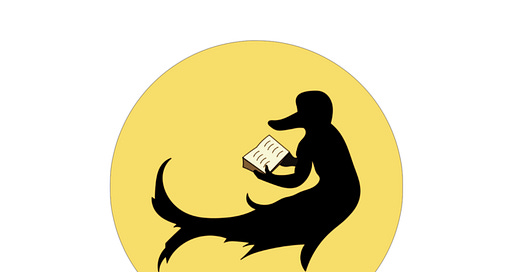Why the Duck-Billed Reader?
This weekly newsletter is about the fun of literature, mostly Victorian - hence the "reader" part. For the duck-bill, read on!
The Basics About This Publication
I write a weekly essay on literature (mostly Victorian), occasionally touching on art or philosophy. For example, I have a series of essays about not-Cinderella stories from three different Victorian authors, all of whom have different ways of subverting the Cinderella story of the impoverished young woman who marries a prince. You can find these essays here, here, and here.
Some of my posts have dipped a toe into philosophy such as this one about characters who outlive their author and this one about a novel by Charles Dickens that led him to quarrel with a prominent intellectual who had been his friend.
All of these essays are intended to share my love of and interest in literature and the arts and to help create a community of people with a shared interest in these things.
In many cases, I’ve included illustrations from the novels that are the subjects of the post or paintings from other 19th century artists, so this publication is also a bit of a 19th century art tour.
I welcome comments and feedback. And of course, I’d be grateful if you shared The Duck-Billed Reader with others using the button below.
So Why Am I Doing This?
I recently walked away from a 30-year career as a lawyer. I was the Head of Intellectual Property at a biotechnology company, and before that, I was a trial lawyer in private practice focusing on patent and trade secret cases.
In addition to working on intellectual property issues, I also litigated many pro bono cases relating to domestic violence, marriage equality, and service by transgender people in the military.
But while I was doing all that, I was also reading Victorian literature of all kinds and participating in book groups. Recently I became the president of The Trollope Society USA, a non-profit society dedicated to the works of Victorian novelist Anthony Trollope, one of my favorite writers.
I am now writing full-time. Unlike most Substack writers, I have no plan to ask for paid subscribers. But I will feel that my efforts have been rewarded if you join The Trollope Society USA here. Please do!
Who Is the Duck-Billed Reader?
The duck-billed reader is an inexplicable yet fascinating figure that appears in The Garden of Earthly Delights, a painting by Hieronymus Bosch.
Detail of Hieronymus Bosch, The Garden of Earthly Delights (c. 1500). Obviously, the yellow-highlighted detail of this detail — the part that shows the duck-billed reader — is my addition.
The painting is a triptych at the Prado museum in Madrid. The detail I’ve shown above is devoted to the story of Adam and Eve in the Garden of Eden. Oddly, the initial meeting between Adam and Eve occurs right next to a murky pool crawling with squabbling creatures that seem anything but paradisiacal.
The duck-billed reader floating serenely in the pool (in the yellow highlight at bottom right) is the strangest figure of all. What reading material exists in the Garden of Eden? Who is this duck-billed creature, and why is it reading? Is it a symbol of the forbidden knowledge the First Couple will soon acquire at the cost of their comfortable home?
Here’s a larger view of the duck-billed reader:
Whatever it means, this creature’s desire to read even when world-historical events are occurring immediately next to it reminds me of my own childhood refusal to look up from my book when my family was driving through the mountains.
Initially, I used the image above as my publication logo. My friend Christina Agapakis (see her excellent Substack about creativity at the intersection of biology and engineering) improved its visibility for me. Then I ran a reader poll to determine a publication name, and The Duck-Billed Reader won. That’s the whole story!








Question. What language is the duck-billed reader's book in? The reader is a chimera of human and fish and duck (when Bosch was painting neither ducked-billed platypuses nor duck-billed dinosaurs were yet known to Europeans). Does the book codeswitch between bird-tongue and fish-talk and human language? Or... is it written in the fabled tongue of Adamic? This was - according to various musings over the centuries - either the language God used to speak to Adam and Eve and/or what Adam used to name the animals. Some supposed Adamic was just Hebrew (on the notion that a child growing up with no language input would naturally speak Hebrew by default). Or else a tongue now forbidden to us (learning a new language = sweat of the brow). Maybe this animal - unlike others - had such a good grasp of language that it already had its own name and didn't need a new one from Adam. I like the idea that the Almighty even picked the little reader to be Adam and Eve's tutor. Maybe the reader acted as translator between the serpent and Eve. Who was speaking Adamic, of course.